Everyone knows that air shipments are much more expensive than shipping via sea or truck, but sometimes, urgent cargo requires a shorter transit time, leaving no other alternatives than shipping by air.
In those cases, it is useful to know how airlines build their transportation costs, to make an appropriate decision on what service to prefer and how costs are built up.
Some of the most important cargo airlines in the world are:
- Cathay Pacific Cargo
- Korean Air Cargo
- Emirates SkyCargo
- Lufthansa Cargo
- Singapore Airlines Cargo
- China Airlines Cargo
- EVA Air Cargo
- Air France Cargo
For air shipments, the cost is calculated by multiplying the rate (provided per kg/lbs) for the “chargeable weight”, which is calculated based on the weight or volume of goods.
The volume/weight ratio is very simple to calculate: 167 kg is estimated for each cubic meter of space (formula: 1 CBM = 167 kg), but if the weight exceeds the chargeable weight, the actual weight will be applied for cost calculation.
Rates/Costs
Each Cargo airline – either those dedicated to the transport of goods exclusively or those who transport goods in addition to passengers – applies different rates based on the type of service chosen and the route offered (direct service versus connecting service).
How to Calculate Costs
Once the cost based on the chargeable weight/actual weight has been established, simple multiplication will be enough to determine the cost of the shipment (net – as mentioned above – of insurance, customs costs, trucking for final delivery, etc.)
A Quick Example of Cost Calculator for the Shipment of Goods
Note: All dimensions/weights are usually calculated using the Metric system.
Example 1
Cost per kg: 2.4kg
Cargo Dimensions: 1200 mm x 800 mm x 1070 mm
CBM: 1.027
Gross weight: 138kg
Chargeable weight: 1.027 X 167 = 171.5kg
In this case the chargeable weight is greater than the gross weight so we need to multiply the cost per KG with the chargeable weight.
Final total cost: 171.5 X 2.4 = $411
Example 2
Cost per kg: 2.4kg
Cargo Dimensions: 1200 mm x 800 mm x 1070 mm
CBM: 1.027
Gross weight: 230kg
Chargeable weight: 1.027 X 167 = 171.5kg
In this case the chargeable weight is less than the gross weight so we need to multiply the cost per KG with the gross weight.
Final total cost: 230KG X 2.4 = $552
Below is an example of how airlines provide rates.
Weight Breaks: the different categories of price ranges.
Destinations, Origins and Carriers, and Costs are made up.
Lower Deck Rates

Main Deck Rates

The Importance of Packaging – how goods can be loaded.
The non-optimization of packaging is a widespread practice, as well as one of the main sources of profit for airlines. Volumetric Cargo (High CBM – Low Weight) is what airlines are after because they can fill the aircraft with low cargo weight and save on fuel.
Goods can be loaded in different ways: in the lower or upper compartment (in passenger aircraft adapted for cargo) or in all-cargo aircraft. In the lower compartment of passenger aircraft there are compartments of various sizes to contain baggage, mail, etc.
Below is a cross-section of a typical cargo aircraft:






5
5
4.5
Comments are closed.